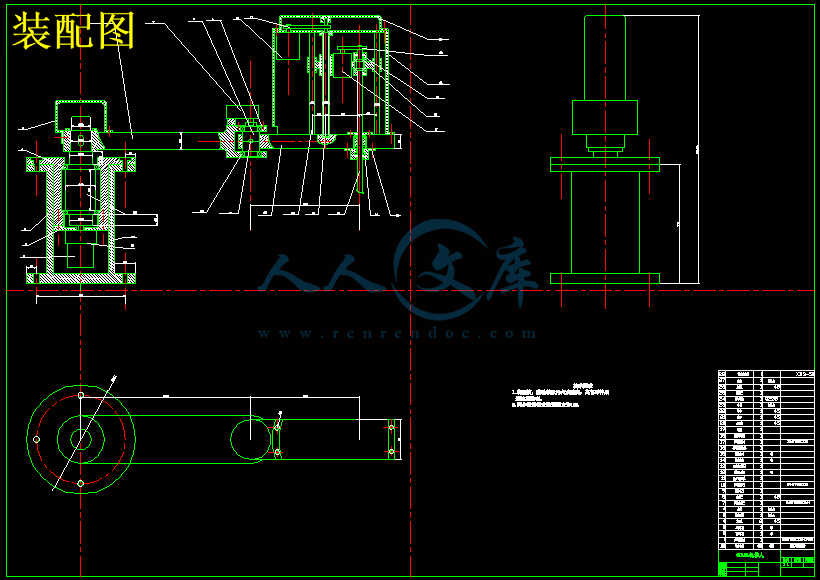目录
第一章绪论 1
1.1引言 1
1.2 国内外机器人领域研究现状及发展趋势 1
1.3 SCARA机器人简介 2
1.4平面关节型装配机器人关键技术 4
1.4.1操作机的机构设计与传动技术 4
1.4.2机器人计算机控制技术 4
1.4.3检测传感技术 5
1.5项目的主要研究内容 6
1.5.1项目研究的主要内容、技术方案及其意义 6
1.5.2拟解决的关键问题 7
第二章SCAAR机器人的机械结构设计 7
2.1 SCARA机器人的总体设计 7
2.1.1 SCARA机器人的技术参数 7
2.1.2 SCARA机器人外形尺寸与工作空间 7
2.1.3 SCARA机器人的总体传动方案 8
2.2机器人关键零部件设计计算 10
2.2.1减速机的设计计算 10
2.2.2电机的设计计算 11
2.2.3同步齿型带的设计计算 11
2.2.4滚珠丝杠副的设计计算 13
2.3大臂和小臂机械结构设计 14
2.4腕部机械结构设计 16
2.5小结 17
第三章SCARA机器人的位姿误差建模 17
3.1基于机构精度通用算法的机器人位姿误差建模 17
3.2机构精度通用算法 18
3.2.2通用机器人位姿误差模型 20
机构通用精度模型与机器人位姿误差模型的联系 20
3.2.2机器人位姿误差模型的建立 20
3.3 小结 25
总结 26
参考文献 27
致谢 28
摘要:工业机器人是最典型的机电一体化数字化装备,技术附加值很高,应用范围很广,作为先进制造业的支撑技术和信息化社会的新兴产业,将对未来生产和社会发展起着越来越重要的作用。
本文设计了一个工业用SCARA机器人。SCARA机器人(全称Selectively Compliance Articulated Robot Arm)很类似人的手臂的运动,它包含肩关节肘关节和腕关节来实现水平和垂直运动。它是一种工业机器人,具有四个自由度。其中,三个旋转自由度,另外一个是移动自由度。它能实现平面运动,具有柔顺性,全臂在垂直方向的刚度大,在水平方向的柔性大,广泛用于装配作业中。
本文用模块化设计方法设计了SCARA机器人的机械结构。分析了SCARA机器人的运动学正解和逆解,建立了机器人末端位姿误差计算模型并做了运动模拟。
关键字: SCARA 位姿误差
4-DOF SCARA robot design and motion simulation
Abstract :Industrial robot is the most typical mechatronic digital equipment, added value and high, wide range of applications, support for advanced manufacturing technology and information society, new industries, and social development of future production will increasingly play a The more important role.
This paper designs an industrial SCARA robot. SCARA robot (full name Selectively Compliance Articulated Robot Arm) is very similar to human arm movement, which includes the shoulder elbow and wrist joints to achieve horizontal and vertical movement. It is an industrial robot has four degrees of freedom. Among them, the three rotational degrees of freedom, the other is the DOF. It can achieve planar motion, with the flexibility, the whole arm in the vertical stiffness, flexibility in the horizontal direction of the large, widely used in assembly operations.
This method was designed with a modular design the mechanical structure of SCARA robot. Analysis of the SCARA robot inverse kinematics, and to establish the position and orientation of robot end of the model error.
Keywords: SCARA analysis
Signature of supervisor:
第一章绪论
1.1引言
机器人技术是综合了计算机、控制论、机构学、信息和传感技术、人工智能、仿生学等多门学科而形成的高新技术。其本质是感知、决策、行动和交互四大技术的综合,是当代研究十分活跃,应用日益广泛的领域。机器人应用水平是一个国家工业自动化水平的重要标志。
工业机器人既具有操作机(机械本体)、控制器、伺服驱动系统和检测传感装置,是一种仿人操作、自动控制、可重复编程、能在三维空间完成各种作业的自动化生产设备。
目前机器人应用领域主要还是集中在汽车工业,它占现有机器人总数的2.89%。其次是电器制造业,约占16.4%,而化工业则占11.7%。此外,工业机器人在食品、制药、器械、航空航天及金属加工等方面也有较多应用。随着工业机器人的发展,其应用领域开始从制造业扩展到非制造业,同时在原制造业中也在不断的深入渗透,向大、异、薄、软、窄、厚等难加工领域深化、扩展。而新开辟的应用领域有木材家具、农林牧渔、建筑、桥梁、医药卫生、办公家用、教育科研及一些极限领域等非制造业。
一般来说,机器人系统可按功能分为下面四个部分川:
l)机械本体和执行机构:包括机身、传动机构、操作机构、框架、机械连接等内在的支持结构。
2)动力部分:包括电源、电动机等执行元件及其驱动电路。
3)检测传感装置:包括传感器及其相应的信号检测电路。
4)控制及信息处理装置:由硬件、软件构成的机器人控制系统。
1.2 国内外机器人领域研究现状及发展趋势
(1)工业机器人性能不断提高(高速度、高精度、高可靠性、便于操作和维修),而单机价格不断下降,平均单机价格从91年的10.3万美元降至2005年的5万美元。
〔2)机械结构向模块化、可重构化发展。例如关节模块中的伺服电机、减速机、检测系统三位一体化;由关节模块、连杆模块用重组方式构造机器人整机;国外己有模块化装配机器人产品问市。
(3)工业机器人控制系统向基于CP机的开放型控制器方向发展,便于标准化、网络化:器件集成度提高,控制柜日见小巧,且采用模块化结构;大大提高了系统的可靠性、易操作性和可维修性。
(4)机器人中的传感器作用日益重要,除采用传统的位置、速度、加速度等传感器外,装配、焊接机器人还应用了视觉、力觉等传感器,而遥控机器人则采用视觉、声觉、力觉、触觉等多传感器的融合技术来进行环境建模及决策控制;多传感器融合配置技术在产品化系统中己有成熟应用。
(5)虚拟现实技术在机器人中的作用己从仿真、预演发展到用于过程控制,如使遥控机器人操作者产生置身于远端作业环境中的感觉来操纵机器人。
(6)当代遥控机器人系统的发展特点不是追求全自治系统,而是致力于操作者与机器人的人机交互控制,即遥控加局部自主系统构成完整的监控遥控操作系统,使智能机器人走出实验室进入实用化阶段。美国发射到火星上的“索杰纳”机器人就是这种系统成功应用的最著名实例。
(7)机器人化机械开始兴起。从1994年美国开发出“虚拟轴机床”以来,这种新型装置己成为国际研究的热点之一,纷纷探索开拓其实际应用的领域。
1.3 SCARA机器人简介
SCARA机器人(如图1一1所示)很类似人的手臂的运动,它包含肩关节、肘关节和腕关节来实现水平和垂直运动,在平面内进行定位和定向,是一种固定式的工业机器人。它具有四个自由度,其中,三个是旋转自由度,一个是移动自由度。3个旋转关节,其轴线相互平行,手腕参考点的位置是由两个旋转关节的角位移p,和pZ,及移动关节的位移Z来决定的。这类机器人结构轻便、响应快,例如Adeptl型SCARA机器人的运动速度可达10m/S,比一般的关节式机器人快数倍。它能实现平面运动,全臂在垂直方向的刚度大,在水平方向的柔性大,具有柔顺性。







 川公网安备: 51019002004831号
川公网安备: 51019002004831号